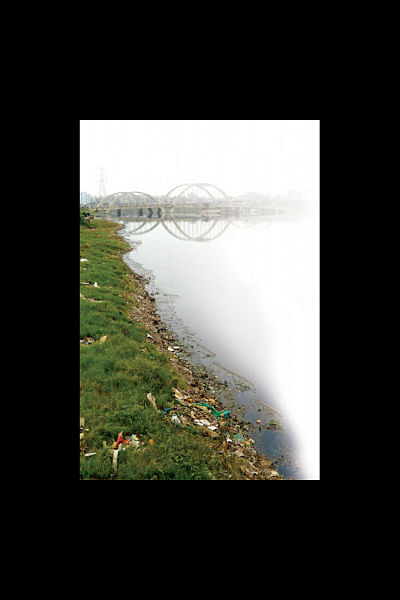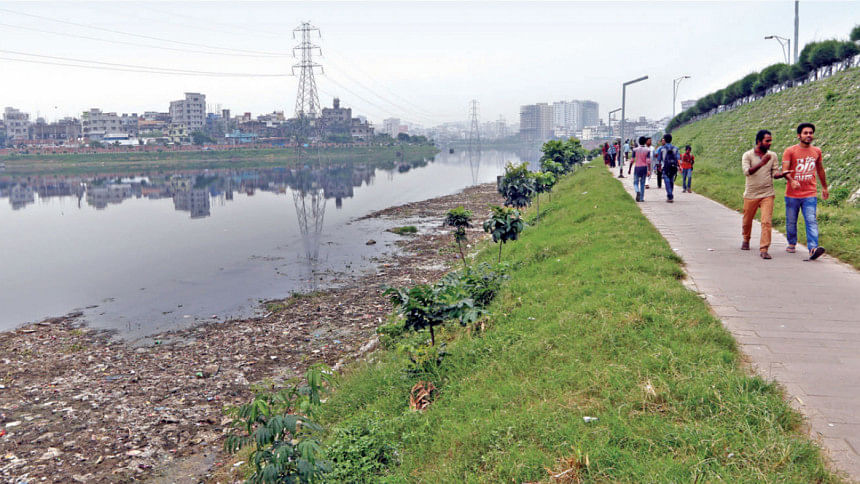The stinking side of the Dream Project

Photos: Prabir Das
The Hatirjheel-Begunbari Lake area, with its open spaces, is steadily losing its charm and beauty due to the unbearable stench of the contaminated lake, coupled with the sight and smell of the garbage heaped in it. Suffocating odour seeping out from the water, gridlocked vehicles at the intersections, contaminated black water stretching as far as one's eyes can see are what one is faced with when they pass through that area.
During the rainy season, the Hatirjheel canal is mainly polluted as sewer waste with storm water is dumped into the canal through 11 outlets. Experts have criticised the existing Special Sewerage Diversion Structure (SSDS), which is designed especially for Hatirjheel, that reroutes the storm water. Sewage lines have proven to be inefficient in dealing with the solid wastes. Through different outlets, the Hatirjheel canal connects with the Balu River, which later joins the Shitalakkhya. So with this canal getting polluted, the water of the two rivers is also getting contaminated.
Architect Iqbal Habib, a consultant of Hatirjheel-Begunbari project believes that it is not possible to clean the water at Hatirjheel simply by adopting ad hoc based plans. Moreover, there is a strong possibility that the waste water will rest on the lake ground as sediments and further spread unpleasant smells in the area. Habib said when the project began, they suggested to concerned authorities that a solar aquatic treatment plant should be set up to remove the odour from the water. "It is a natural mechanism of cleaning water by using solar power and water hyacinth. Unfortunately, they did not give heed to our advice. We fear if this continues, the sedimentation process will create more difficulties," he says.
Mahmud Hossain, a resident of south Begunbari, knows nothing about the structural and the technical problem; all he wants is a better place for living, "When it rains, the polluted water smells far worse. Our lives are becoming inhumane. The government should come forward to solve the problem," he says.

Bangladesh University of Engineering and Technology (BUET) experts believe that without a proper waste water treatment plant, there is no way out from the stagnant, contaminated water. However, the responsible authorities, Rajdhani Unnayan Kartripakkha (RAJUK) and Dhaka Water Supply and Sewerage Authority (DWASA), claim that they permitted the wastes into the lake only during the rainy season. But they also admit their decision will not help the present situation.
The civil engineering department head of BUET, Professor Mujibur Rahman, explains that under the project, a screen has been installed at the entrance of the sewage line to stop solid wastes from entering the lake. But in the rainy season, the screen was blocked by huge solid wastes, so water flowed back and caused water blockage in Dhanmondi, Kalabagan and Panthapath areas. "DWASA removed the fixed screen as an instant solution to deal with the water stagnation and it worsened the condition. They were supposed to separate the sewage and storm water drainage system to keep the urban landscape and rain water retention area neat and clean," says Rahman.
Following the SSDS, only rain water was supposed to enter the lake through different box culverts. The plan aimed at retaining the rainwater, but with the absurd connection - along with rainwater - solid wastes are also entering the lake now. "We expect that the lake will remain clean but at the same time, we are connecting sewage lines with the storm water line, thereby polluting the whole area. This is absolutely ridiculous," he adds.

The DWASA is currently looking for donors to fund water treatment plants. Land acquisition for the project is ongoing and they have already requested the Economic Relations Division (ERD), through the Local Government and Rural Development (LGRD) ministry, to find a donor. Managing Director of DWASA, Taqsem A Khan, says that any government work procedure takes time but the authoritative body is prioritising the project.
The Bangladesh government has already spent Tk. 10.48 billion on a single 10-kilometre express road stretching from east to west; six bridges add to the well-planned commuting network that has lessened traffic congestions in adjoining areas, particularly Badda, Gulshan, Moghbazar, Mouchak, Rampura, Tejgaon and Begunbari. With the delay in starting the waste water treatment plant, the cost for structural development is shooting up every day.
Kingbodontir Dhaka, a book by Nazir Hossain, says that during the 19th century, the British government and the local zaminders used Hatirjheel for the purpose of bathing elephants. But after the end of the British period, the historical place was covered with illegal structures. Almost five years ago, the government took up the project to recover the 304 acres of land and the city's largest rain retention basin. Undoubtedly, the new appearance of the lake attracts a large number of city dwellers. People have found a new place to meet up with friends and family, but, without proper maintenance and essential renovation work to correct the inherent flaws of the project, this little spot of respite is reverting back to the smelly garbage dump it once was.

Read More HATIRJHEEL REEKS

 For all latest news, follow The Daily Star's Google News channel.
For all latest news, follow The Daily Star's Google News channel. 



Comments